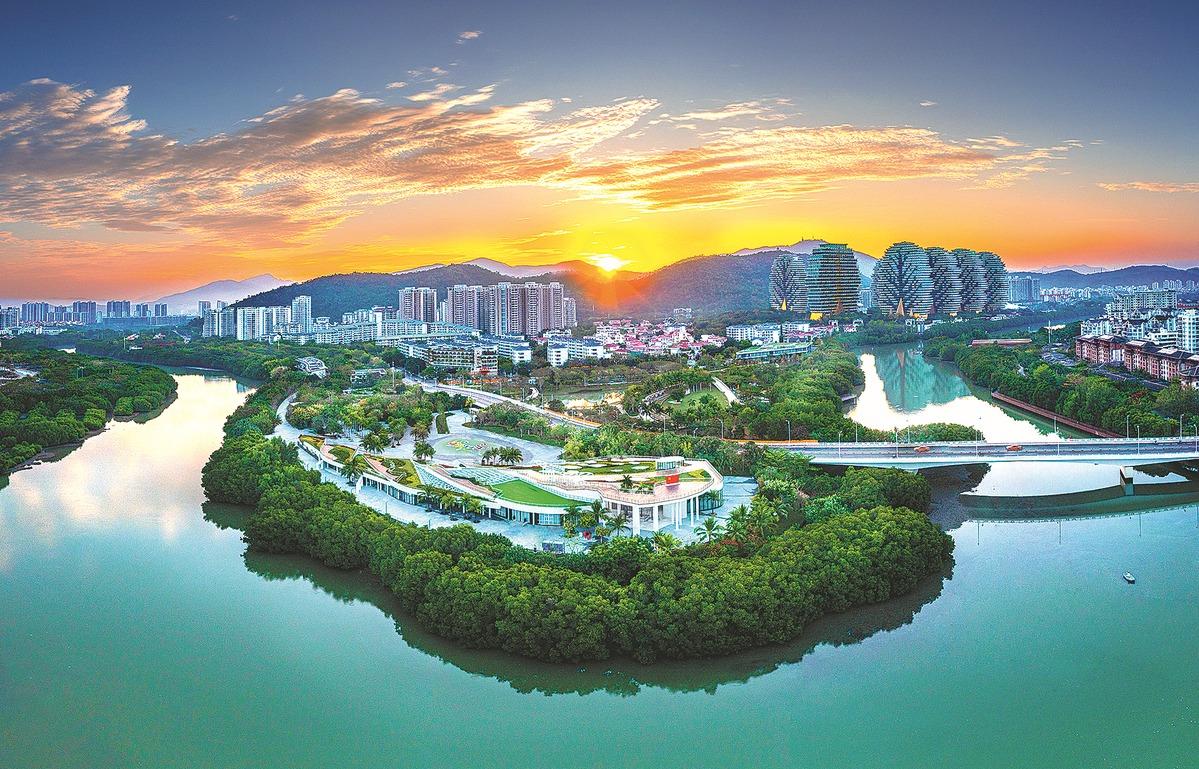Editor's note: Over the past several years, Hainan province has vigorously optimized its business environment and tourism. The construction of the Hainan free trade port has achieved fruitful results and significantly boosted the development of the province, writes a veteran journalist with China Daily.
 An aerial photo of a riverside park in Sanya, Hainan province. (PHOTO PROVIDED TO CHINA DAILY)
An aerial photo of a riverside park in Sanya, Hainan province. (PHOTO PROVIDED TO CHINA DAILY)
Having spent a three-week vacation in Hainan, I carried back to Beijing mixed feelings of love and hate about the island, feelings I believe are shared by many visitors and local residents.
Owning a small apartment in Sanya, I used to go to the tropical island province every Spring Festival to escape the freezing cold in Beijing. The country's strict pandemic control measures prevented me from doing so for three years. When I visited Hainan during Spring festival this year, I found a lot of impressive changes.
The central government has implemented a number of preferential policies to facilitate Hainan’s development
Dozens of apartment buildings have come up around our building's compound, dwarfing the 20-story building. A trestle bridge now connects the two sides of a river nearby, making it ideal for an after-dinner walk. And a huge supermarket close by has made life more convenient.
News reports also say investments of billions of dollars are pouring into Sanya and the rest of the province, and several high-tech development zones and science parks are under construction. With a new duty-free shop opening earlier this year, the island now has more than 10 such shops that attract hundreds of thousands of customers looking for luxury goods at a lower price every day.
While the "hardware" progress is impressive, Hainan's "software" development has much room for improvement. Most of the people I talked with, including taxi drivers, restaurant waiters, farmers, vendors and retired people who use the island as a winter retreat, gave their thumbs down to the services on the island.
The cabbie who drove me to the airport told me that he had been working extra hours recently to make more money from the temporary brisk business. "Once the Southeast Asian countries are fully open to Chinese tourists, many Chinese tourists would choose to go there rather than coming to Hainan," he said. "Anyway, who will pay more for poorer services?" he said.
When my neighbors — most of whom are from outside the island — sit together near the swimming pool in our building's compound, the topic of discussion is usually about the difficulty in getting a temporary residence permit. Also, people who don't speak the local dialect are asked to pay more for vegetables and fruits by the vendors.
High commodity prices have long been the bane of both visitors and locals in Hainan. Housing prices have increased threefold in the past eight years. Apartments now sell for 20,000-30,000 yuan ($2,911-$4,367) per square meter in Sanya, which is higher than that in many provincial capitals. Food in restaurants cost one-third more than in Beijing, whose average income is about twice as much as Hainan's.
Rising prices as well as frequent reports of cheating and overcharging by restaurants, hotels, cabbies and travel agents are damaging the island's image and probably scaring away many potential tourists.
Due to its tropical climate, Hainan is an ideal winter retreat for many retired people from northern China, especially northeastern China where winter lasts five to six months. Statistics show that of the more than 10 million people living in Hainan, an estimated 1 million are from northern China, with many of them being from Northeast China.
Returning to Hainan after three years, I came to know that several people from the northeastern and other parts of China have either annulled their rental housing contracts or sold their apartments in the hope of shifting to other places with sea, sand and sunshine.
The central government has implemented a number of preferential policies to facilitate Hainan's development. Local governments at different levels, too, are trying to implement such policies to turn the island into an ideal tourist destination. Accordingly, campaigns have been launched to check cheating, overcharging, price hiking and dereliction of duty by officials.
But the results, as I saw and heard during my three-week stay on the island, appear far from satisfactory, indicating that local governments still have a lot to do to improve the environment in Hainan. Only when all the businesses and officials ensure that both residents and visitors get the best services can Hainan become an ideal place for residents and a real tourist paradise.
The author is former deputy editor-in-chief of China Daily.


